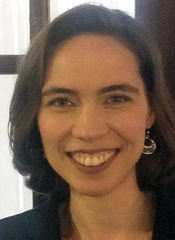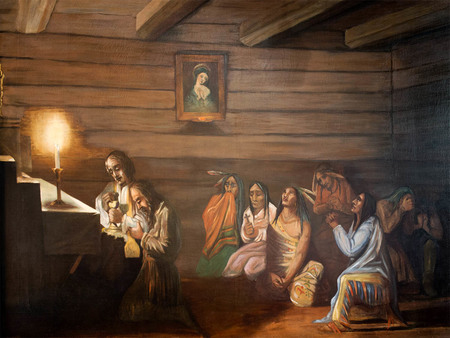 Gabrielle Guillerm
Gabrielle Guillerm
Gabrielle Guillerm is a Ph.D. candidate in history at Northwestern University. Her dissertation will examine French Catholicism in the early American west. She was awarded a 2017 Research Travel Grant to pursue work on this topic at the Notre Dame Archives. Benjamin Wetzel, a postdoctoral fellow at the Cushwa Center, recently met with Guillerm to discuss her work.
Applications for the next round of travel grants and research awards from the Cushwa Center are due December 31, 2017.
BW: Can you briefly describe your project for us?
GG: My dissertation, “The Forgotten French: Catholicism, Colonialism, and Americanness on the early trans-Appalachian Frontier,” focuses on the Midwest and Kentucky and aims to recover the French Catholic story of the early United States. I posit that, compared to the colonial period, French Catholic cultural influences strengthened in the West over the early republican period even as the proportion of Francophone Catholics in this former French territory diminished. The development of these new French Catholic influences resulted from the French Revolution. Refugee priests in the United States created new Catholic networks between France and the United States. These networks intensified in the early 19th century and were embodied by the circulations of hundreds of female and male missionaries and thousands of religious objects. French clergy built French religious orders and schools after French examples—the Congregation of Holy Cross and Notre Dame for instance—and spread popular French devotions, such as the devotion of the Sacred Heart. Non-French clergy themselves relied on the connections with France, which further contributed to spreading French Catholic influences.
 Painting "Last Communion of Father Louis De Seille" in Notre Dame's Log Chapel *
Painting "Last Communion of Father Louis De Seille" in Notre Dame's Log Chapel *
This project seeks to understand how French Catholics and French Catholic influences fit into the new nation. Analyzing the encounter between Catholics and other trans-Appalachian populations, I argue that defining American identity was a contentious process, and central to this contestation were French Catholic missionaries and French Catholics. Indeed, French missionaries’ status in the new nation was ambivalent: they were both threats to the country and agents of the nation’s agenda in the West, insiders and outsiders. On the one hand, they spread an alternative understanding of the new nation that challenged the assertion of the American identity as Anglo-Protestant; on the other hand, they took an active part in the building of the colonial settler nation promoted by the U.S. government.
BW: How do you see your project intervening in the scholarly literature?
GG: My dissertation works at the intersection of several fields. Historians who study the impact of the French Revolution on the early United States have generally emphasized the political and diplomatic impact of the revolutionaries. But by focusing on refugee priests, my dissertation goes further, showing that counter-revolutionaries were also part of the young republic’s history. Through their actions in the West, French émigré priests directly participated in the making of the U.S. colonial settler state as they also began to spread French Catholic influences on Western education, politics, and public life. As importantly, by establishing and maintaining networks between France and the United States, the émigré priests allowed for French Catholic and cultural influences to persist beyond the French Revolution.
This project also contributes to the historiography of the early republic and the making of the new nation. Historians of the early republic have begun to appreciate how fluid and contested American identity was at this time, especially in the context of westward expansion, and a few have shown how the ongoing French interest and presence in this region beyond 1763 complicated Anglo-American hegemony. However, their studies exclude the specifically Catholic dimension of French influences. My dissertation, instead, analyzes French influences and the encounter between French missionaries and other trans-Appalachian populations through the lens of religious material and intellectual culture. This method allows for an understanding of the everyday experience of Catholics amid the struggle for cultural and religious position on the frontier, along with competing definitions of Americanness.
Lastly, this project contributes to the history of U.S. Catholicism. It complicates the dominant understanding of early U.S. Catholicism, which rests on a national framework and unfolds from east to west. I argue, instead, that U.S. Catholicism resulted from global connections and, at the same time, had regional and even local specificities. In the trans-Appalachian West, a Catholic center characterized by French influences and connections developed simultaneously to the better-studied eastern center. In addition, while recent transnational studies have begun to recover French influences on early U.S. Catholicism, they have largely ignored the contributions of French nuns to the making of Catholicism in the early republic. My dissertation will correct this omission, not simply by including these sisters in the story but also by showing how formative their role was in the emerging Church. I will show that, through their French-inspired schools and devotions, priests and nuns together, in relation with each other, influenced ordinary Catholics’ everyday lives.
BW: What are your goals for this project in the next several years?
GG: After writing my dissertation, I hope to revise it for publication.
BW: What resources did you find especially helpful at the ND archives?
GG: The Notre Dame archives have extensive resources for my project. The (arch)diocesan collections (Detroit, Vincennes, Cincinnati, St. Louis, and Baltimore) are the most helpful and document the entire 70 years of my project, including the late 18th century. These collections have clerical correspondence that record missionary work and travels, institutional aspects, and circulations of missionaries and religious objects between France and the United States. I also found in these collections a wealth of documents on (and often by) French Catholics who descended from settlers in French colonial North America: petitions, subscriptions for the erection of new churches, rules and list of members of confraternities, correspondence, etc. They show that, contrary to what missionaries often claimed, the old French were not only devout Catholics, but some also played an important part in building the frontier Church. One of my most exciting findings is that several Francophone women, most of them the daughters of Native American women and French traders, assisted male missionaries by teaching in frontier Catholic schools and serving as interpreters between priests and Native Americans. Some of these women also joined and helped develop French religious congregations. Lastly, the diocesan collections have more documents on missions among Native Americans than I expected.
The archives also have collections on the priests and sisters of Holy Cross. Unfortunately, I barely had time to tackle them but am planning to return to do so.
BW: How did you become an historian of American religion?
GG: I initially was an historian of French religion with an interest in the United States. At the Sorbonne, I wrote my master’s thesis on French Catholic influences on the early American Catholic Church, using primarily sources I found in French archives. This was a valuable experience, which gave me a sense of the repositories and sources available in France to study U.S. Catholicism. However, I realized that if I wanted to continue working on this topic I needed to get a more serious training in American history and American religious history. The coursework years of my Ph.D. program at Northwestern provided me with the knowledge to devise and research this project.
BW: Is there anything else you’d like to tell us?
GG: Besides the collections I consulted, I was lucky to meet other scholars with interests close to mine in the archives. Kevin Cawley facilitated some of the introductions and others happened by chance. In any case, my visit was a great opportunity to expand my network!
While I was at Notre Dame, I visited the exhibit “Preserving the Steadfastness of Your Faith”: Catholics in the Early Republic. Despite all the interesting things I saw there, I noticed that the West was almost absent. The focus was on Anglo-Catholics on the east coast and I saw almost nothing about the French, which reinforced my conviction that this project is needed.
* This painting depicts Father De Seille among the Potawatomi Indians of the St. Joseph mission, Indiana. While it evidences Francophone priests' missionary endeavors and the existence of Catholic Indians, Guillerm notes that the omission of Angelique Campeau, De Seille's translator, is telling of the omission of women's missionary work.
